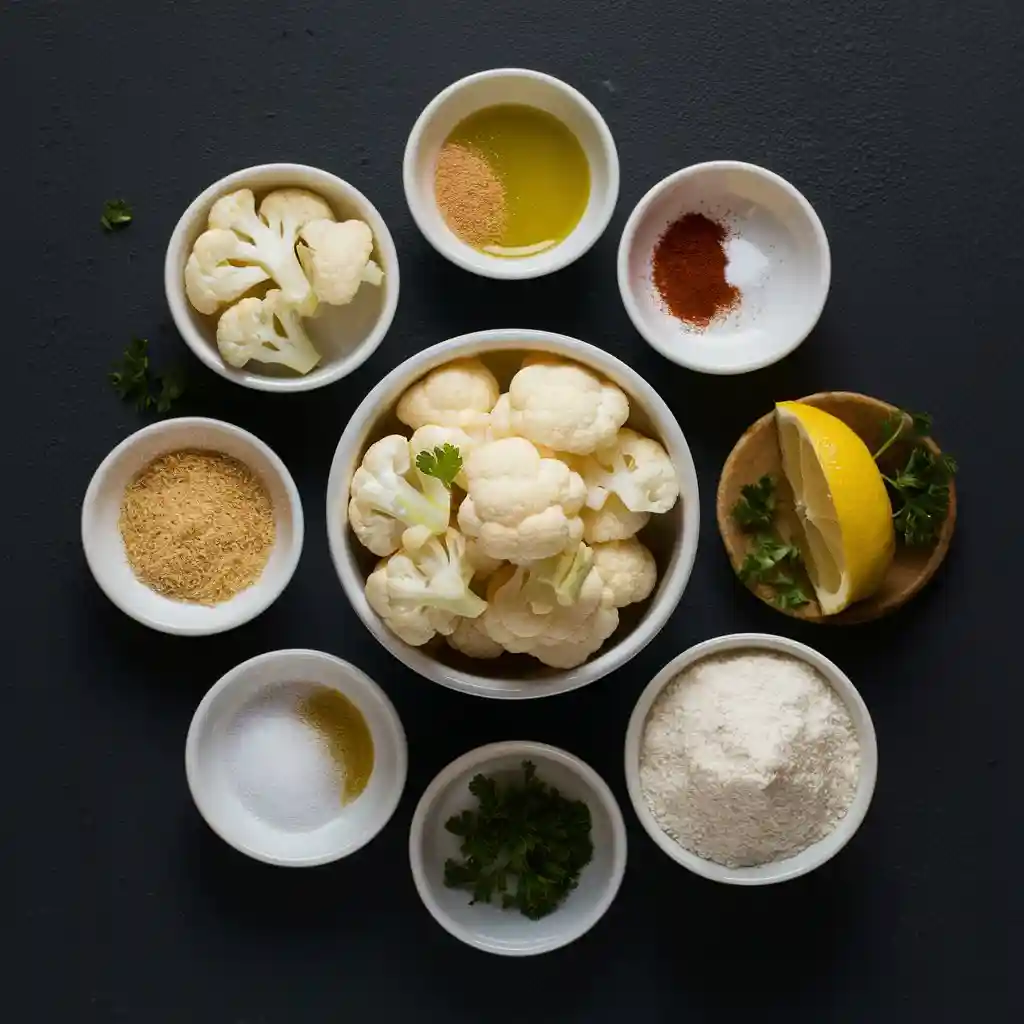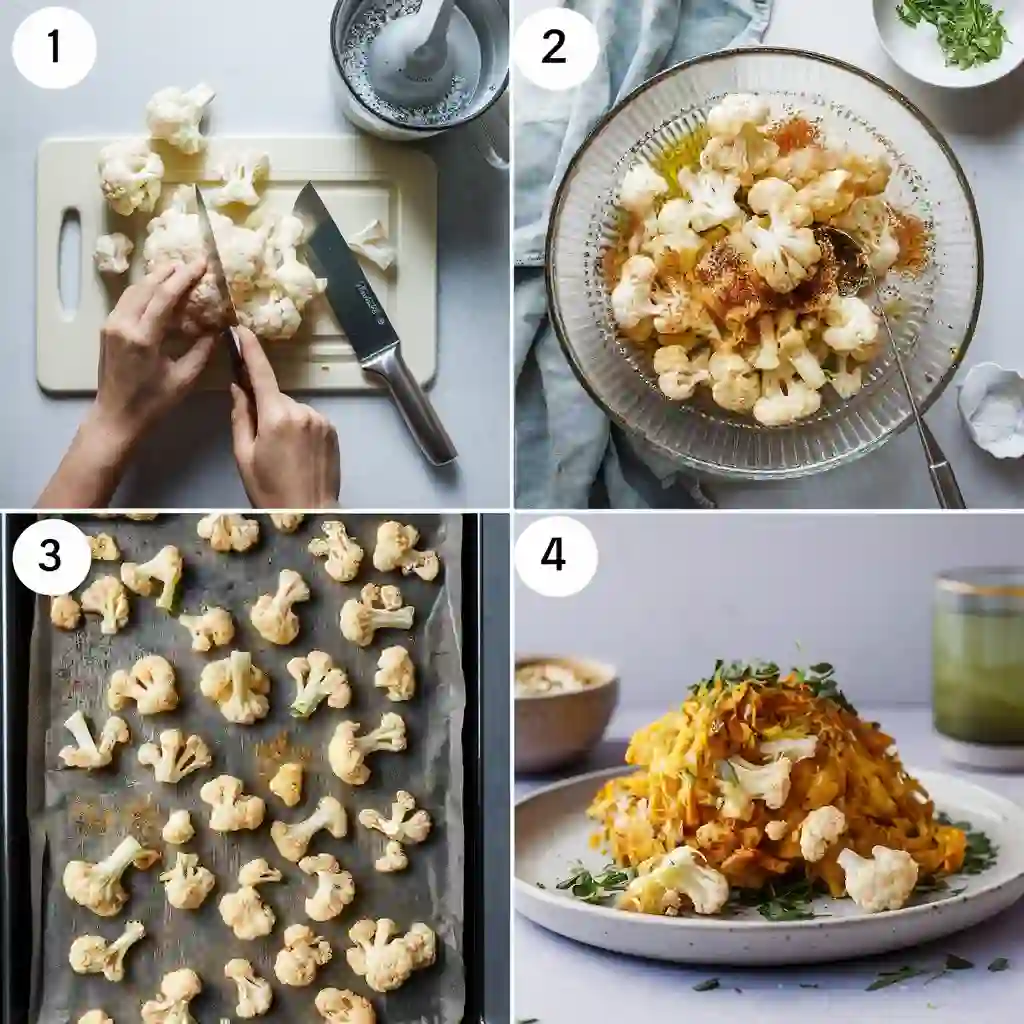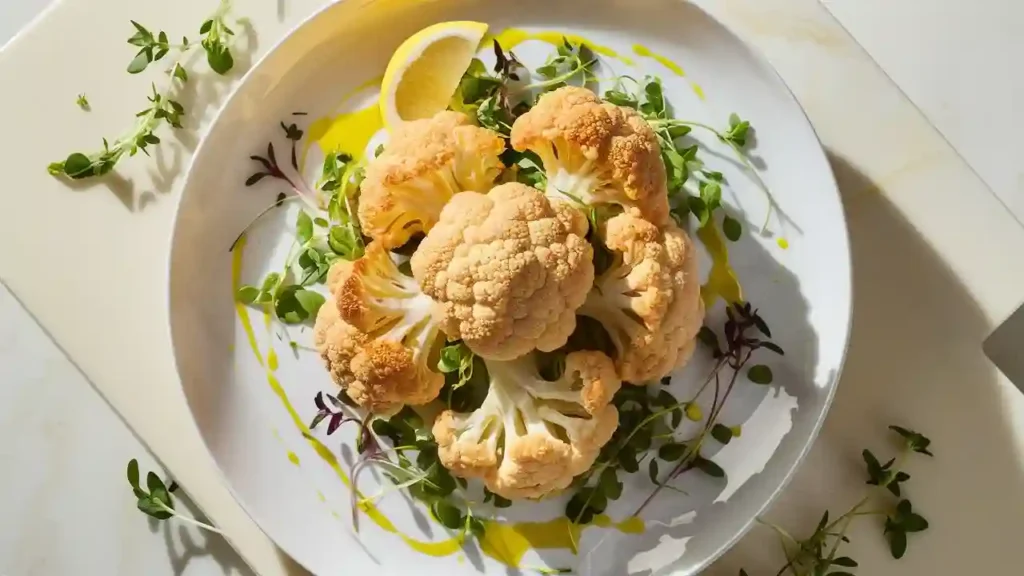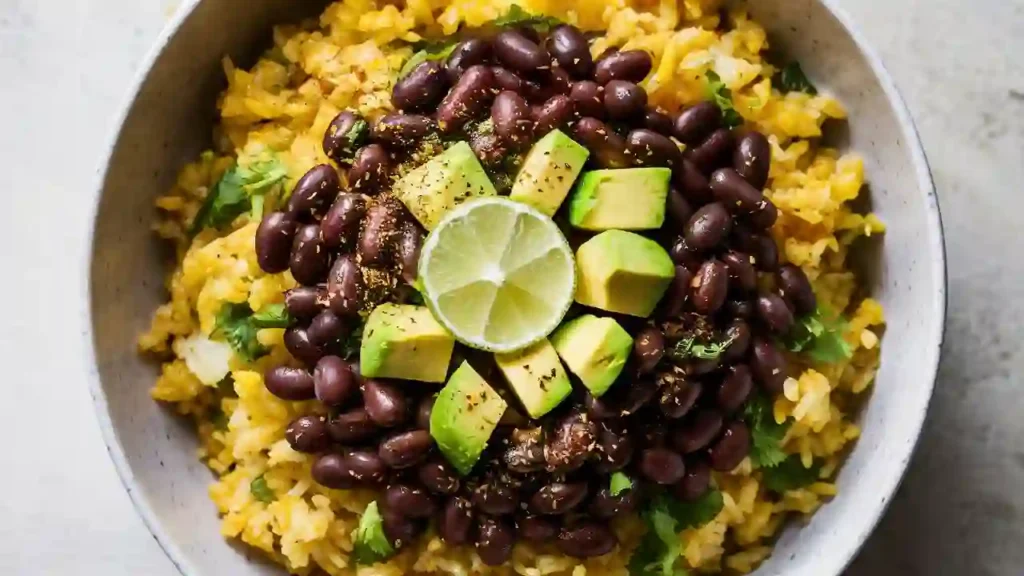Last Updated on August 4, 2025 by Lucas
Have you ever fallen in love with a vegetable? I sure did when I discovered how a roasted cauliflower recipe can transform tender cauliflower florets into garlic‑parmesan perfection in under 30 minutes. This quick 30‑minute cauliflower side dish also doubles as my favorite low‑carb cauliflower recipe (Cauliflower Rice hack included) for feel‑good dinners. With olive oil, garlic and simple spices—no fuss, all flavor—you get crisp-golden bites you’ll actually crave. Whether served solo or tucked into a vegetarian cauliflower bowl, it’s proof that wholesome doesn’t mean boring.
Key Benefits of This Cauliflower Recipe
You’ll love why this cauliflower recipe earns its place at your table. Each point gives real value.
Here’s how it stands out:
1. Nutrient power‑house in every bite
- Low in calories, high in fiber. Two grams per cup supports fullness.[1][2]
- Rich in vitamin C (~51 mg), vitamin K (~16 µg), folate, B6 and choline.[3]
- Meets clean‑eating, keto and gluten‑free needs with ease.
2. Gut‑friendly and naturally filling
- With fibre, it helps you feel satisfied longer.[4]
- Low‑sugar and mostly water. Keeps appetite in check.
3. Completes in under 30 minutes
- Gets from prep to plate in around half an hour. This is your quick cauliflower side dish.
- Perfect when you need fast and flavorful meals.
4. Versatile and shows your creativity
- Try flavorful twists: roasted garlic‑parmesan, curried, or with taco seasoning.
- Works brilliantly as cauliflower rice or in bowls like Southwest‑style or Asian stir‑fry.
Smooth transition words
But there’s more: flavor balance, ease of prep, and kitchen‑friendly flexibility draw people back again.
With this recipe you get nutrition, speed and taste in one simple dish.
Ingredients
This cauliflower recipe calls for simple staples you probably have on hand.
It’s great for a quick, low‑carb cauliflower recipe.
You’ll find the ingredients easy to prep.
Let’s break them down:
| Ingredient | Quantity | Notes |
| Cauliflower florets or head | ~6–8 cups (2–3 lb) | Trimmed and evenly sized for even roasting |
| Extra‑virgin olive oil | ~1½ Tbsp | Or sub avocado oil for sensitivity |
| Garlic (cloved or powder) | 2 cloves / ½ tsp | Fresh gives brightness; powder gives ease |
| Smoked paprika or curry mix | ½ tsp | For smoky or warm spice profiles |
| Kosher salt & freshly ground black pepper | to taste | Adjust to highlight natural sweetness of cauliflower |
Ingredient Checklist

Optional add‑ins for variation:
- Add avocado, black beans, sweet potatoes or kale to build Southwest‑inspired bowls.
- Try cauliflower rice bowls with garlic‑parmesan, curried or taco seasoning for flavor variety.
Your kitchen toolkit:
- Food processor for cauliflower rice.
- Roasting pan or air‑fryer baskets for easy cleanup.
- Mixing bowls, tongs or spatula for tossing and flipping florets.
👍 Transition tips & storage insight
Meanwhile, freeze any extra cauliflower florets to preserve freshness.
Stored properly, raw cauliflower stays crisp in the fridge for up to 5 days.[5]
It’s best kept stem‑side up in a perforated bag.
🔍 Why these ingredients work
First, cauliflower florets deliver rich fiber (~2 g per cup) and nutrients like vitamins C, K and choline.[6]
You’re building a recipe that hits clean‑eating, keto and gluten‑free audiences—yet still feels indulgent.
Second, olive oil and spices amplify flavor without needing creamy sauces.
Finally, everything ties back to the title promise: a 30‑min wholesome bite that’s easy to tailor.
Instructions
Preparing this cauliflower recipe is simple, fast, and rewarding.
Let’s walk through it together.
1. Prep Cauliflower Quickly
- Start by removing the outer leaves from your cauliflower head.
- Trim the stem and cut into even‑sized florets (about 1.5–2 inches).
- Want a low‑carb option? Pulse the florets in a food processor using short bursts.
- This creates a fluffy cauliflower rice texture without turning it mushy.
📝 Tip: Uniform pieces help everything roast evenly and crisp well.
2. Season and Roast (or Air Fry) to Crispy Perfection
- In a large bowl, toss the florets with olive oil, garlic, and your chosen spices.
- Spread them out on a baking sheet, cut‑side down. Avoid overcrowding.
- Roast in a preheated oven at 425 °F for 20–25 minutes.
- Flip the florets halfway through to ensure golden, crispy edges.
➡️ Air Fryer Option: Cook at 400 °F for about 15 minutes, shaking once at the halfway mark.
3. Finish with Seasoning and Garnish
- After roasting, sprinkle with Parmesan (or nutritional yeast for a dairy‑free version).
- Add fresh garlic or garlic powder for extra depth.
- Roast 5 minutes more for a crispy topping.
- Finally, squeeze fresh lemon juice and scatter chopped parsley on top.
🌿 Bonus: The lemon brightens the earthy notes of roasted cauliflower.
4. Optionally Plan Ahead
- This recipe is great for meal prep.
- Cool completely before storing in an airtight container.
- Keep in the fridge for up to 4 days.
- Reheat in a hot oven or air fryer to bring back that crispiness.
- Want to freeze? Use cauliflower rice and store flat in freezer bags.

📚 Storage Tip: For best texture, avoid freezing whole roasted florets.[7]
With these steps, you’ll create a flavorful cauliflower recipe that fits your schedule and taste.
Next time you need a healthy side or quick lunch, you know what to make.
Pro Tips & Variations
Elevate your roasted cauliflower experience with these expert tips and creative variations. Whether you’re aiming for a crispier texture, exploring bold flavors, or seeking digestive-friendly options, these insights have you covered.
🔥 Roasting Hack for Perfect Caramelization
To achieve that irresistible crispy texture:
- Cut Side Down: Always place the florets with the cut side facing down on the baking sheet. This maximizes contact with the hot surface, ensuring optimal browning and caramelization.
- Skip the Parchment: Avoid using parchment paper. Direct contact with the baking sheet promotes better crisping.
- High Heat: Roast at 425°F (220°C) for 20–25 minutes. Flip halfway through to ensure even browning.
🌿 Flavor Twists to Try
Experiment with these variations to keep your cauliflower dishes exciting:
- Garlic Parmesan: Toss florets with olive oil, minced garlic, and grated Parmesan (or nutritional yeast for a vegan option). Roast as usual for a savory delight.
- Curried Cauliflower: Season with a blend of garam masala, turmeric, and cumin for a warm, spiced profile.
- Buffalo Style: After roasting, toss florets in hot sauce and serve with a side of ranch or tahini for dipping.
⚡ Quick Cooking Methods
Pressed for time? Try these faster cooking methods:
- Air Fryer: Preheat your air fryer to 200°C (400°F). Toss cauliflower florets with olive oil and seasoning. Air fry for 12–15 minutes, shaking the basket halfway through for even crisping .
- Stovetop Stir-Fry: For cauliflower rice, heat olive oil in a wok over medium-high heat. Add cauliflower rice and minced garlic, stir-frying for 5–7 minutes until tender.
🌱 Digestive-Friendly Tips
If cauliflower tends to cause digestive discomfort, consider these strategies:
- Lightly Steam First: Steaming cauliflower before roasting can help break down its complex carbohydrates, making it easier on the digestive system .
- Incorporate Digestive Aids: Cooking with spices like cumin, fennel, or ginger can aid digestion and reduce bloating .
- Gradual Introduction: If you’re not accustomed to high-fiber vegetables, start with small portions and gradually increase to allow your digestive system to adjust .

Feel free to experiment with these tips and variations to find your perfect roasted cauliflower recipe. Whether you’re aiming for a quick snack, a flavorful side dish, or a digestive-friendly option, these insights will guide you to delicious results.
Serving Suggestions
Transform your cauliflower recipe into a satisfying meal with these creative ideas. Whether you’re aiming for a hearty vegetarian bowl, pairing with protein, prepping for the week ahead, or seeking the perfect dip, these suggestions will elevate your dish.
🥗 1. Vegetarian & Full Meal Bowls
Create a balanced and flavorful bowl by combining your cauliflower recipe with:
- Southwestern Cauliflower Rice Bowl: Mix black beans, diced avocado, a sprinkle of taco seasoning, and a squeeze of lime for a zesty touch.
- Asian-Inspired Stir-Fry: Steam cauliflower rice and toss with peanut sauce and chopped scallions for a savory, nutty flavor.

These combinations offer a satisfying mix of textures and flavors, making your cauliflower dish the star of the meal.
🍗 2. Protein Pairings
Enhance your cauliflower recipe by pairing it with:
- Grilled Chicken: The smoky flavor complements the cauliflower’s mild taste.
- Chickpea Shawarma Style: Spiced chickpeas add a hearty, plant-based protein option.
- Vegan Meat Alternatives: Products like tempeh or tofu provide a satisfying bite for vegan diets.
These protein additions not only boost the nutritional value but also add depth to the overall flavor profile.
🥡 3. Meal Prep-Friendly Formats
Make your cauliflower recipe a convenient option for the week ahead:
- Portion into Lunch Boxes: Layer with grains or greens for a balanced meal.
- Store Dressings Separately: Keep sauces like tahini or yogurt-based dressings in separate containers to maintain freshness.
This approach ensures your meals stay fresh and flavorful throughout the week.
🥣 4. Dipping Ideas & Sides
Complement your cauliflower recipe with these dipping sauces and sides:
- Tahini Yogurt Sauce: A creamy blend that adds richness.
- Chimichurri: A tangy, herbaceous sauce that adds a burst of flavor.
- Lemon Herb Dip: A refreshing dip that balances the cauliflower’s earthiness.
- Flatbread or Cauliflower Crust Pizza: For a more substantial side, these options pair well with the dish.
These additions provide a variety of flavors and textures, enhancing the overall dining experience.
By incorporating these serving suggestions, you can transform your cauliflower recipe into a versatile and satisfying meal suitable for any occasion.

Conclusion
This Cauliflower Recipe Love truly lives up to its name—it’s a delightful blend of nutrition, flavor, and versatility. Packed with essential vitamins and antioxidants, cauliflower supports immune function and promotes digestive health . Its adaptability allows you to customize it to your taste preferences, whether you’re roasting, air frying, or sautéing. Plus, it’s a quick and easy dish that fits seamlessly into your busy schedule. Why not give it a try tonight? Share your creation on social media using the hashtag #CauliflowerRecipeLove and inspire others to enjoy this wholesome, delicious dish. Whether you’re looking for a nutritious side or a satisfying main, this recipe is sure to become a favorite in your culinary repertoire.
FAQs
Can I use frozen cauliflower florets?
Yes, frozen cauliflower florets can be used in this recipe. However, ensure they are thawed and excess moisture is removed to achieve the desired crispiness. Roasting frozen cauliflower might result in a slightly softer texture compared to fresh florets.
Is Parmesan optional if vegan? What’s a substitute?
Absolutely. For a vegan version, omit the Parmesan. A suitable substitute is nutritional yeast, which offers a cheesy flavor without dairy. Alternatively, vegan cheese shreds can be used for a similar taste and texture.
Why does cauliflower sometimes make me gassy? How to reduce it?
Cauliflower contains fiber and certain carbohydrates that can cause gas in some individuals. To minimize this, consider lightly steaming the cauliflower before consuming it. This method can help break down some of the complex sugars, making it easier to digest. Additionally, gradually increasing your intake can help your digestive system adjust.
Can I prep this entirely ahead and freeze?
Yes, you can prepare the cauliflower ahead of time and freeze it. After roasting, allow the cauliflower to cool completely before storing it in an airtight container or freezer bag. When ready to serve, reheat in the oven or air fryer to restore its crispiness.
Is the recipe still healthy if I add cream or cheese?
Incorporating cream or cheese can enhance the flavor and richness of the dish. However, it’s important to note that this will increase the calorie and fat content. For a healthier alternative, consider using lighter versions of cream or cheese, or plant-based substitutes, to maintain the dish’s nutritional balance.
How to transform baked florets into cauliflower rice bowls?
To create a cauliflower rice bowl, pulse the baked cauliflower florets in a food processor until they reach a rice-like consistency. Sauté the cauliflower rice with your choice of vegetables and seasonings. Top with proteins like grilled chicken, tofu, or chickpeas, and finish with a drizzle of sauce for added flavor.
What is the healthiest way to eat cauliflower?
The healthiest way to consume cauliflower is by steaming or roasting it. These methods preserve its nutrients, including fiber, vitamins, and antioxidants, while minimizing the need for added fats. Avoiding deep-frying helps maintain its healthful properties.
Why do you soak cauliflower before cooking?
Soaking cauliflower before cooking can help remove any residual dirt, pesticides, or insects that may be present. Submerging the florets in a saltwater solution for about 15 minutes, then rinsing them thoroughly, ensures they are clean and ready for cooking .

Cauliflower Recipe
Equipment
- Food processor for cauliflower rice.
- Roasting pan or air fryer baskets for easy cleanup.
- Mixing bowls, tongs or spatula for tossing and flipping florets.
Ingredients
- 1 medium head of cauliflower cut into florets
- 2 tablespoons olive oil
- 1 teaspoon garlic powder
- 1 teaspoon paprika
- Salt and pepper to taste
- Optional: ¼ cup grated Parmesan or nutritional yeast
- Juice of ½ lemon
- Fresh parsley chopped, for garnish
Instructions
Prep the Cauliflower:
- Trim the cauliflower into bite-sized florets. For a rice-like texture, pulse in a food processor using wide, short pulses.
Season and Roast:
- In a large bowl, toss the florets with olive oil, garlic powder, paprika, salt, and pepper. Arrange them cut-side down on a baking sheet. Roast at 425°F (220°C) for 20–25 minutes, flipping halfway through, until golden and crispy.
Finish and Garnish:
- If using, sprinkle Parmesan or nutritional yeast over the cauliflower during the last 5 minutes of roasting. Once done, squeeze lemon juice over the top and garnish with chopped parsley.
Serve:
- Enjoy as a side dish, over grains, or as a main course with your favorite protein.
Video
Notes
- Calories: 120 kcal
- Protein: 3g
- Fat: 9g
- Carbohydrates: 10g
- Fiber: 4g
- Sugar: 2g
- Sodium: 180mg

